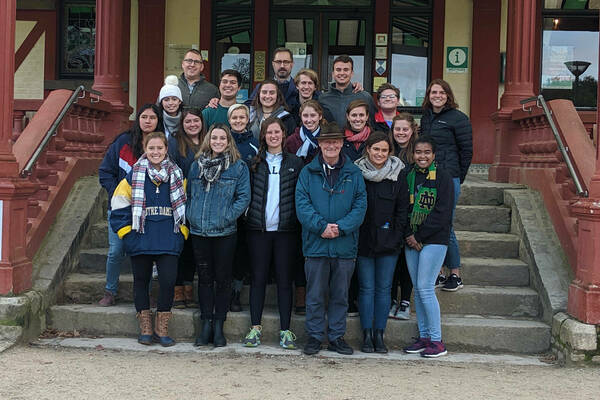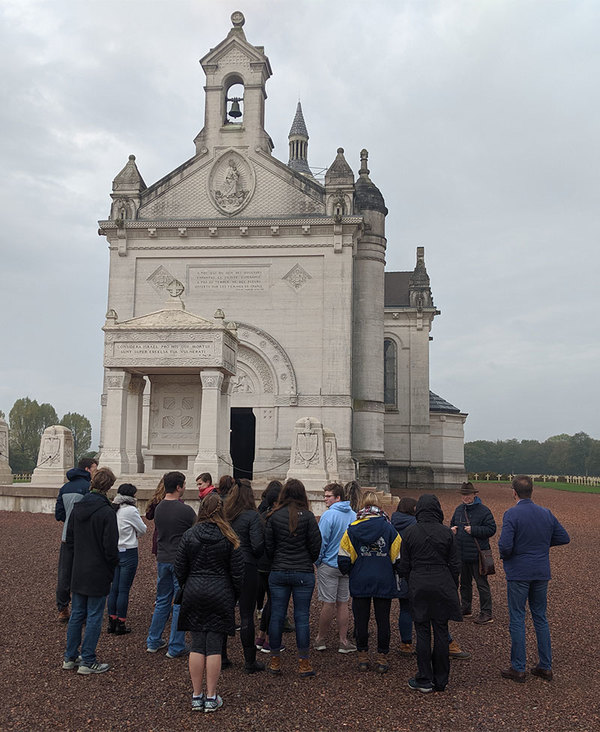
The Great War and Modern Memory class — led by Robert Norton (top row, middle), a professor of German, and John Deak (top row, left), an associate professor of history — traveled to Europe to visit battlefields and World War I memorials last semester.
More than 20 million people were killed and another 20 million or more were injured in World War I, but it’s difficult for Americans today to wrap their minds around just how catastrophic the conflict was. The last survivors have died, the war wasn’t fought on American soil, and it ended more than a century ago.
But a group of Notre Dame students now has more than numbers, texts, or photos to help them understand the devastation.
As part of their Great War and Modern Memory class — an interdisciplinary course designed and team-taught by Robert Norton, a professor of German, and John Deak, an associate professor of history — they traveled to Europe to visit battlefields and World War I memorials along the western front.
The trip was fully funded through an Arts and Letters Teaching Beyond the Classroom grant and support from the Nanovic Institute for European Studies.
“It was an extraordinary opportunity that I hope we can replicate,” Norton said. “I’ve had colleagues at other institutions say, ‘I wish we could do that, but it would be impossible for us.’”
“We wanted the students to physically experience the sites where so many of the important events of the First World War took place because we believe that gives the students an otherwise not possible insight into the nature of the war and how it’s described in literary and scholarly accounts.”

In visiting sites across Europe, the class combined conventional battlefield analysis with the
collective and individual things people did to understand and come to terms with the war.
A valuable insight
The goal for the class was to combine conventional battlefield analysis with the collective and individual things people did to understand and come to terms with the war, Norton said.
“We wanted the students to physically experience the sites where so many of the important events of the First World War took place because we believe that gives the students an otherwise not possible insight into the nature of the war and how it’s described in literary and scholarly accounts,” he said.
For Morgan Zepf, an anthropology and biological sciences major, that point was driven home at the memorial for the Battle of Verdun, which lasted for 10 months and ended with more than 300,000 dead and nearly a half-million more missing or wounded.
“As hard as you can try to get the most in-depth and coherent history in a classroom, there’s only so much you can gain,” she said. “Being able to actually be in these places, the death became real, especially when you’re standing in cemeteries with thousands of graves each.”
Like Zepf, many students wanted to more fully grasp World War I, Norton and Deak said, and understand the role it played in setting the table for the rise of Adolf Hitler, Joseph Stalin, the Cold War, and so much more.
“With texts in books, you can divorce yourself from it,” Deak said. “But when you travel and experience these things firsthand, a lot of that information comes to life. You see how people make sense of the suffering brought on by the war.”

The class visited Douaumont ossuary, a memorial in France honoring soldiers who died during the Battle of Verdun.
A different lens
Norton and Deak hoped to mimic the “grand tour” style of education long experienced by English aristocrats who would travel around Europe for several years, learning new languages, reading important texts, and visiting art collections. It’s a model still employed on a smaller scale in some ways, Norton said. British schoolchildren tour important World War I sites on the western front, for example.
“Tourism, looked at properly, should be and has been a very important part of education, broadly conceived,” Norton said. “You can view the Sistine Chapel’s ceiling virtually now, but being there in person is better. We still believe that actual physical experience trumps virtual experience.”
The trip also offered students a chance to see the war through different lenses. Not only do class readings include books authored by French, British, and German authors, but touring sites in many of those countries showed students the overall impact of a four-year war that the U.S. only joined for the last seven months.
“It was never as fully present in the American collective consciousness as it has been elsewhere,” Norton said. “Now they’ve seen how the memory of the war varies according to the cultural context. France treats it much differently than Great Britain, and it’s complex in Germany where it’s not really recognized.”
The class also has fostered a closeness among students in a way that Norton and Deak believe has freed them to express their own ideas more freely. The trip abroad, in particular, found them supporting each other while visiting emotionally challenging places.
“Seeing them interact and discuss their ideas has been rewarding,” Deak said. “They’re always ready and willing to challenge an idea or talk. That has been a difference between this class and others I’ve been teaching.”
“As hard as you can try to get the most in-depth and coherent history in a classroom, there’s only so much you can gain. Being able to actually be in these places, the death became real, especially when you’re standing in cemeteries with thousands of graves each.”
Originally published by at al.nd.edu on January 28, 2020.